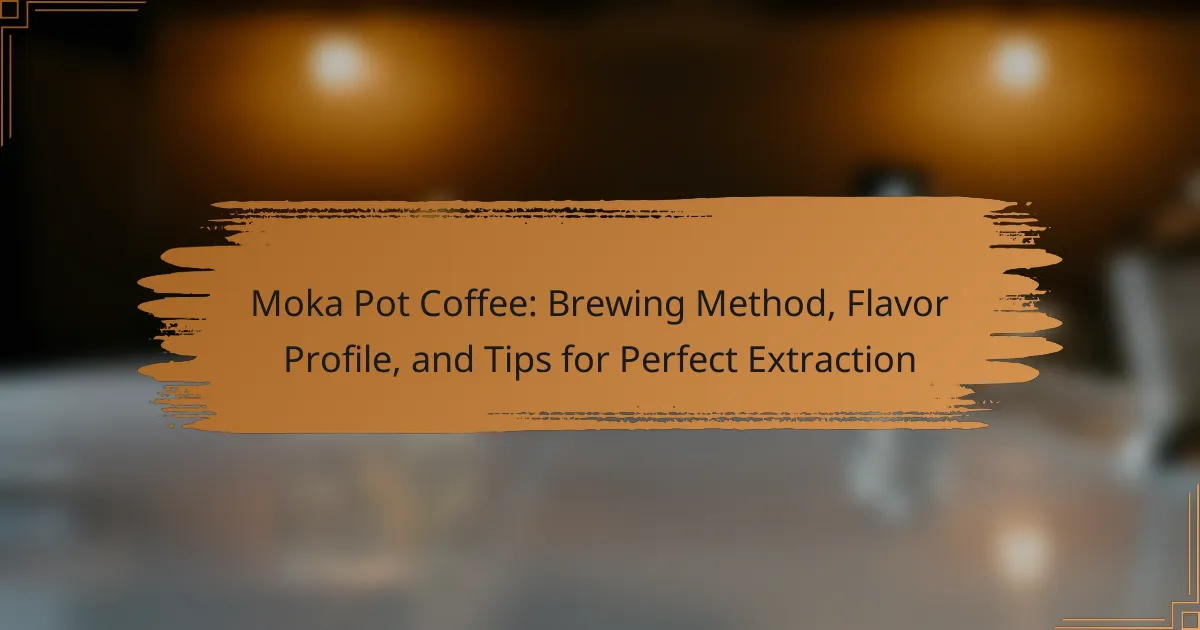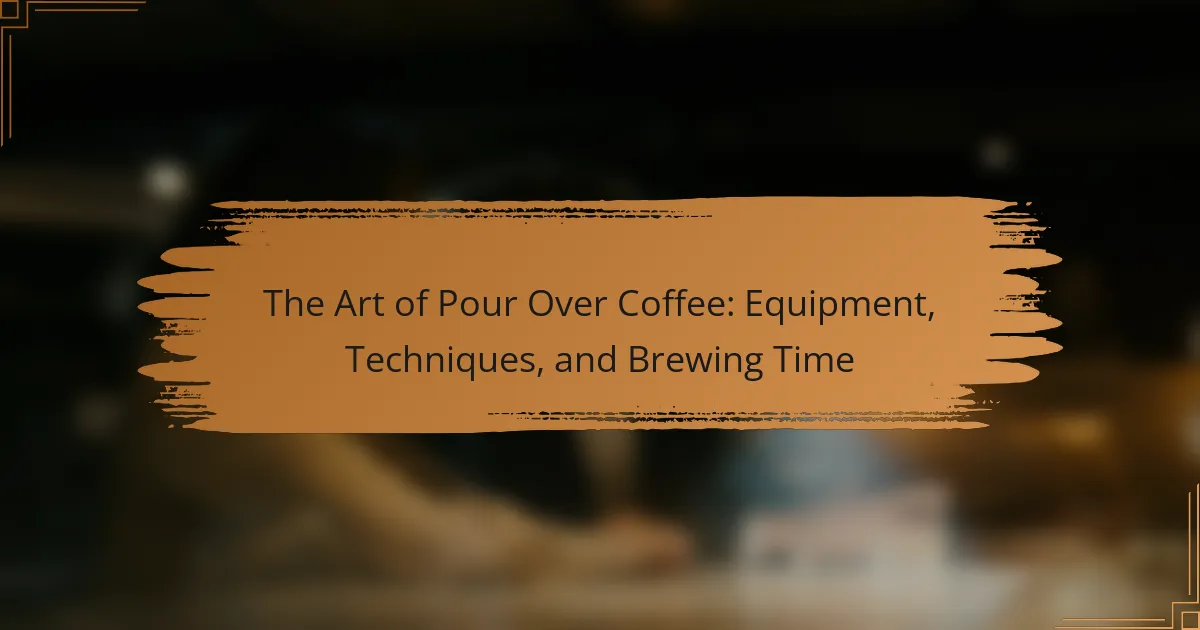
What is Moka Pot Coffee?
Moka Pot coffee is a type of coffee brewed using a Moka pot, also known as a stovetop espresso maker. This brewing method utilizes steam pressure to push hot water through coffee grounds. The result is a rich, concentrated coffee with a strong flavor profile. Moka pots were invented in Italy in the 1930s and have become popular worldwide. The coffee produced is often compared to espresso but is less intense. Moka pots are typically made from aluminum or stainless steel. They are available in various sizes, accommodating different coffee servings. The brewing process usually takes about five minutes on the stovetop.
How does the Moka pot work for brewing coffee?
The Moka pot brews coffee using steam pressure. Water in the bottom chamber heats up and produces steam. This steam creates pressure that forces water upward through a coffee grounds basket. The water extracts flavors from the coffee as it passes through. Finally, the brewed coffee collects in the top chamber. The Moka pot typically brews coffee at a temperature of around 90-95 degrees Celsius. This method produces a rich, strong coffee similar to espresso. The process relies on the unique design of the pot, which includes a sealed chamber for pressure buildup.
What are the main components of a Moka pot?
The main components of a Moka pot are the bottom chamber, filter basket, and top chamber. The bottom chamber holds water. The filter basket contains coffee grounds. The top chamber collects brewed coffee. Additionally, there is a safety valve that regulates pressure. Each component works together to brew coffee effectively. This design has remained largely unchanged since its invention in 1933 by Alfonso Bialetti.
How do these components interact during the brewing process?
During the brewing process in a Moka pot, water, coffee grounds, and pressure interact to produce coffee. Water is heated in the lower chamber, creating steam. This steam increases pressure, forcing water up through the coffee grounds in the filter basket. The coffee grounds extract flavors, oils, and aromas as water passes through them. The brewed coffee then flows into the upper chamber. The interaction of heat, pressure, and coffee grounds is crucial for optimal extraction. Proper temperature and grind size significantly influence the flavor profile of the resulting coffee.
What are the key features of Moka Pot Coffee?
Moka Pot Coffee is characterized by its unique brewing method and flavor profile. The Moka pot uses steam pressure to force water through coffee grounds. This results in a strong, concentrated coffee similar to espresso. The brewing process typically takes about 5 minutes.
Moka pots are usually made from aluminum or stainless steel. They come in various sizes, accommodating different coffee quantities. The coffee produced has a rich, bold flavor with a slightly bitter aftertaste.
Moka pots are also known for their ease of use and portability. They can be used on gas, electric, or induction stovetops. This versatility makes them popular among coffee enthusiasts.
What brewing method is used in Moka pots?
The brewing method used in Moka pots is called pressure brewing. This method involves boiling water in the lower chamber, creating steam pressure. The steam forces water up through the coffee grounds in the middle chamber. The brewed coffee then collects in the upper chamber. Moka pots typically operate at a pressure of about 1.5 to 2 bars. This pressure enhances the extraction of flavors from the coffee grounds. The result is a strong, espresso-like coffee. The design of the Moka pot enables this unique brewing process.
How does the brewing method affect the flavor profile?
The brewing method significantly influences the flavor profile of Moka pot coffee. Moka pots utilize steam pressure to extract coffee, leading to a unique taste. This method produces a rich, bold flavor with a pronounced aroma. The brewing temperature and time also play crucial roles. Higher temperatures can enhance bitterness, while longer brewing times may lead to over-extraction. Additionally, the grind size affects the extraction rate. Finer grinds increase surface area, intensifying flavors. Research shows that brewing methods directly correlate with flavor compounds in coffee. Thus, the choice of brewing method is essential for achieving desired flavor profiles.
What are the unique benefits of using a Moka pot?
The unique benefits of using a Moka pot include its ability to brew rich and flavorful coffee. Moka pots utilize steam pressure to extract oils and flavors, resulting in a strong coffee concentrate. This method is known for producing a coffee with a bold taste profile, similar to espresso but less intense. The aluminum or stainless steel construction ensures even heating and durability. Moka pots are also compact and portable, making them ideal for travel or small kitchens. Additionally, they are easy to use and require no electricity, providing a traditional brewing experience. The affordability of Moka pots compared to espresso machines adds to their appeal. Overall, the Moka pot offers a unique combination of convenience, flavor, and cost-effectiveness for coffee enthusiasts.
How does Moka Pot Coffee compare to other brewing methods?
Moka Pot Coffee produces a strong, espresso-like brew, distinguishing it from other methods. Compared to drip coffee, Moka Pot Coffee has a richer flavor and higher caffeine concentration. It utilizes steam pressure to extract oils and flavors, unlike French press, which relies on steeping. The brewing time is shorter than cold brew, which takes several hours. Moka Pot Coffee often results in a thicker texture due to its brewing process. Additionally, it offers a more intense aroma compared to pour-over methods. Overall, Moka Pot Coffee provides a unique taste experience that sets it apart from traditional brewing techniques.
What are the advantages of Moka pot coffee for home brewers?
Moka pot coffee offers several advantages for home brewers. It produces a rich and robust flavor profile that many coffee enthusiasts appreciate. The brewing process is straightforward and does not require electricity, making it convenient for various settings. Moka pots are typically affordable and accessible, appealing to budget-conscious consumers. They also allow for precise control over brewing time and coffee strength. Additionally, Moka pots are durable and easy to clean, ensuring longevity and ease of maintenance. This method can yield coffee comparable to espresso, enhancing the home brewing experience.
How can you achieve the perfect extraction with a Moka pot?
To achieve the perfect extraction with a Moka pot, use the right coffee grind and water temperature. A fine to medium grind is optimal for Moka pot brewing. This grind size allows for proper extraction without clogging the filter. Use filtered water heated to just below boiling, around 200°F (93°C). This temperature ensures the coffee extracts fully without burning. Fill the bottom chamber with water up to the safety valve. Add coffee grounds to the filter basket without pressing them down. Assemble the Moka pot tightly to prevent steam leaks. Place the pot on medium heat and monitor closely. Remove the pot from heat once you hear a hissing sound, indicating extraction is complete. These steps maximize flavor and aroma in the coffee.
What factors influence the extraction process in Moka pot coffee?
The extraction process in Moka pot coffee is influenced by water temperature, grind size, and brewing time. Water temperature affects the solubility of coffee compounds. Ideally, water should be between 90°C and 95°C for optimal extraction. Grind size impacts the surface area of coffee in contact with water. A medium-fine grind is recommended for balanced extraction. Brewing time also plays a crucial role; it typically ranges from 4 to 5 minutes. Longer brewing can lead to over-extraction, resulting in bitterness. Each of these factors must be carefully controlled to achieve the desired flavor profile in Moka pot coffee.
How do grind size and coffee-to-water ratio affect extraction?
Grind size and coffee-to-water ratio significantly affect coffee extraction. A finer grind increases the surface area of coffee, leading to faster extraction. This can enhance flavor but may also introduce bitterness if over-extracted. Conversely, a coarser grind slows extraction, resulting in a milder flavor profile.
The coffee-to-water ratio determines the strength and balance of the brew. A higher ratio of coffee to water intensifies flavor and body. A lower ratio results in a lighter, more diluted coffee. Optimal extraction typically occurs with a ratio between 1:15 and 1:18.
Research shows that ideal grind size and ratios lead to balanced flavors. A study from the Specialty Coffee Association indicates that maintaining these parameters is crucial for achieving desired taste profiles.
What tips can enhance your Moka pot coffee experience?
Use fresh, finely ground coffee for the best flavor. A medium to fine grind allows for optimal extraction. Fill the filter basket evenly without pressing down. This ensures uniform water flow through the coffee. Use filtered water for a cleaner taste. Impurities in tap water can affect flavor. Heat the Moka pot on medium heat. High heat can lead to burnt coffee. Remove the pot from heat as soon as you hear a hissing sound. This indicates brewing is complete. Pre-warm the Moka pot with hot water. This helps maintain consistent brewing temperature. Clean the pot thoroughly after each use. Residue can affect future brews. Enjoy your coffee immediately for the best flavor experience. Freshly brewed coffee tastes best when served right away.
What common mistakes should be avoided when brewing with a Moka pot?
Common mistakes to avoid when brewing with a Moka pot include using the wrong grind size. A fine grind can clog the filter, while a coarse grind leads to weak coffee. Another mistake is not filling the water chamber correctly. Insufficient water can result in burnt coffee, while overfilling can cause spills. Additionally, neglecting to clean the Moka pot regularly can lead to residue buildup, affecting flavor. Using high heat is another error. It can cause uneven extraction and bitter taste. Lastly, not preheating water can lead to longer brewing times, affecting the final flavor.
How can you troubleshoot common issues with Moka pot coffee?
To troubleshoot common issues with Moka pot coffee, identify the problem first. If the coffee is weak, check the grind size; it should be medium-fine. If the coffee tastes burnt, reduce the heat during brewing. If water leaks from the pot, ensure the gasket is intact and properly seated. If the coffee does not brew at all, check that the water chamber is filled and that the filter is not clogged. If the coffee is bitter, consider using fresher coffee beans. Each of these adjustments can improve the brewing process and enhance flavor.
Moka Pot Coffee is a type of coffee brewed using a Moka pot, which employs steam pressure to extract flavors from coffee grounds. This method produces a rich, concentrated coffee with a flavor profile similar to espresso but less intense. The article covers the components and brewing process of the Moka pot, factors influencing extraction, and tips for achieving optimal flavor. Additionally, it compares Moka pot coffee to other brewing methods and highlights its unique benefits for home brewers. Key aspects such as grind size, water temperature, and coffee-to-water ratio are discussed to enhance the brewing experience.



